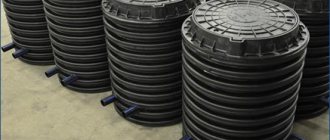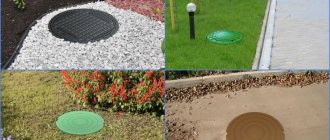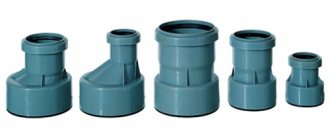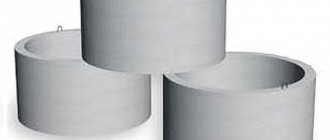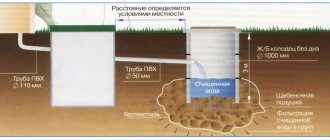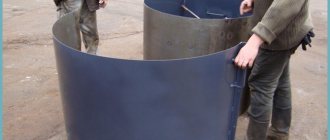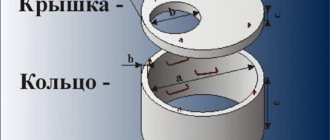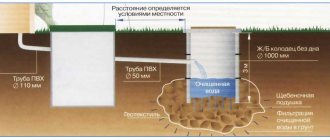Structural features of sewer wells
Regardless of the type of well - concrete, plastic or brick, they are united by a single design scheme. It is a cylindrical or rectangular shaft, in which there is a tray for waste liquid at the bottom. It can have different branches, bends and holes intended for pipes (inlet and outlet). The ceiling with the hatch may also be different.
When arranging an external drainage network with the installation of a sewer well for various purposes, you must adhere to the requirements prescribed in SNiP 2.04.03-85.
Sewage wells can be serviced (their diameter reaches 1000 millimeters) or unserviced (then this parameter is smaller).
Until recently, the latter objects were almost never installed. Regardless of whether the wells are concrete or plastic, they are classified according to their purpose:
- viewing – linear, control, nodal, rotary;
- variable.
Inspection wells are used in the following cases:
- in places where branches are connected;
- when there is a need to turn the sewer line;
- when changing pipe diameter or degree of slope.
It is important to choose the correct distance between sewer inspection wells, which may depend on many factors.
Drop wells are installed in areas where there is a difference between the levels of incoming and outgoing pipes. They are also used when the speed of water flow changes or at intersections with underground objects.
The requirements for the location interval of control structures require the implementation of large volumes of construction work - excavation and installation. If you use plastic sewer rings for wells (such as in the photo), then you can significantly reduce labor costs and the time required to complete the work.
Installation of plastic rings for technological structures
The principle of constructing plastic wells for any purpose is the same. The only exception is when working with soils prone to swelling. To prevent the container from being pushed out, the plastic rings are “anchored.” To do this, the depth of the pit must be greater than the height of the plastic capsule. Gravel is poured into the bottom of the pit, and a kind of “anchor” is placed on top in the form of a concrete slab with ears or hooks built into it. The dimensions of the anchor must exceed the bottom of the well. The plastic parts are attached to the concrete with cables, and the space between the pit and the walls of the well is filled with gravel. For heaving lands, medium and coarse gravel is better suited, rather than “native” soil.
Which is better: plastic or concrete rings
Until relatively recently, when constructing a sewer system, there was no alternative to concrete rings and brick structures.
In addition, the use of other materials was not permitted by building standards and regulations. The advantage of concrete products is as follows:
- low cost;
- the ability to build a sewer well of the required depth;
- modularity of ring sizes.
But the disadvantages of concrete products are more significant. The fact is that it is impossible to determine in advance at what angle the rings will enter the well, so manufacturers very rarely produce products with pre-made holes. When installing a reinforced concrete sewer well, installers must first pierce the concrete in certain places, and then seal these holes hermetically after laying the pipes. For a similar reason, the tray at the base is made by hand from mortar.
It should be noted that PVC sewer rings do not have the disadvantages inherent in a concrete structure; all this is provided for in them in advance. One of the advantages of plastic products is that their shaped parts can easily withstand high temperatures and large volumes of liquid waste.
In addition, plastic sewer rings have much less weight compared to concrete products. To install reinforced concrete products, it is necessary to use lifting mechanisms. At the same time, polymer rings can be transported by passenger vehicles and installed with your own hands without the use of special equipment.
The use of concrete products in the construction of sewer systems does not provide the necessary tightness, as a result of which wastewater can penetrate into the soil. If there is a need to raise the level in order to lay a new asphalt surface, the work process will be significantly more complicated.
Construction of a well with a monolithic shaft
In construction, a self-fill well with lowering formwork turns out to be several times cheaper than a standard one made of rings. The owner does not have to spend money on buying rings, their delivery and labor-intensive installation. Construction requires formwork made from boards. A square section is easier to make than a round one, so most of the filling wells are square.
The formwork consists of two parts: external and internal. They are placed inside each other, and the sizes are selected so that the gap between the walls is 15 cm. To prevent the solution from sticking to the structure, the surfaces that will be in contact with the concrete are covered with a durable film.
The place for the well is cleared, the necessary building materials and equipment are prepared. As with reinforced concrete rings, a pit is dug to accommodate the formwork. Before the first pouring, a wooden beam cut diagonally is laid on the bottom of the frame. It is placed so that after the solution hardens, a cutting lower edge is formed. The pointed edge will help the monolith sink faster.
The seams between the rings are the weakest point in the well. Their waterproofing requires constant diagnostics and periodic repairs. There are no seams in a monolithic well, so it will be much more reliable and easier to maintain
The installed and centered formwork is secured with pins that will hold its parts in the correct position. Wooden spacers can be used instead. A reinforcing mesh is placed in the gap between the wooden walls. Its upper edge should protrude 15-20 cm above the formwork to ensure reliable fastening to the next section of the well. The mesh needs to be fixed with pieces of lath so that it is in the mortar mass.
The recommended proportion for preparing the solution is 1:3:3 (cement-sand-crushed stone). Ready concrete must be plastic. Excessive moisture and its lack significantly worsen its characteristics. The solution is poured into the gap in portions of 2-3 buckets, followed by bayoneting and vibration with a wooden strip. The spacers that hold the reinforcement are carefully removed as the section is filled. The filled segment is left to harden for 2-3 days. Next, the formwork is carefully dismantled, and the beam that formed the oblique is removed.
Next, the formwork needs to be reassembled, but based on the finished section. An important point is to control the relative verticality of the frozen segment and the formwork. The film needs to be changed on each section. After centering the structure, concrete is poured again and reinforcement is gradually added. Instead of a mesh, the frame can be bent from individual wires.
When the second section hardens well, you can begin lowering the shaft. As with rings, two people are required: one to dig inside, the second to lift the soil to the surface. The shaft must be deepened evenly so that the casing does not warp during settlement. As soon as the column goes down to the required depth, the formwork is installed and poured again, and so on until a well of the required depth is obtained.
The main problem when digging a well, which does not depend on the skill of the builders, can be a large boulder. Stones up to 100 kg in size can be dug and pulled to the surface using a winch. Hammers and grinders are used for crushing
The external design of a monolithic well is not particularly different. The head is raised to a height of 70-100 cm above the ground surface. Due to the lack of seams, you don’t have to worry about external waterproofing. What types of well houses there are and how to install them are described in this article.
Types of sewer manholes
Hatches are distinguished according to the load they can withstand and their functional purpose:
- A15 (up to 1.5 tons) - used in the arrangement of green areas and pedestrian paths;
- B125 (up to 12.5 tons) – used in parks and parking lots;
- C250 (up to 25 tons) - used for road surfaces in urban areas;
- D400 (up to 40 tons) – for highways.
The hatches also differ in the location of installation on the neck:
- on a ring of unloading type;
- to the mine;
- on a retractable telescopic tube.
The method involving installation of the hatch directly on the shaft is used only for option A15 (pro
Which brand of concrete is most preferable?
Concrete rings often act as supporting elements and therefore must withstand significant loads. For this reason, these products are made from heavy concrete. All rings are necessarily reinforced with a mesh welded from reinforcement bars.
Most manufacturers produce products of this type from B15 (M200) concrete. This is the best option in all respects. But they often offer cheaper rings, made of B10 (M150) concrete. This is also a good option, but you need to understand that there is a difference between these products, and a significant one.
| M150 | M200 |
| — 11% of the total mass Portland cement I-II 32.5. — sand fraction 1.5-2 mm - coarse aggregate: limestone or gravel — water permeability w2 (needs additional waterproofing) — frost resistance F50 (within 50-75 freeze-thaw cycles) — strength 131 kgf/cm² | — 30% of the total mass Portland cement M400 — sand fraction 0.15-2 mm - coarse aggregate: limestone or gravel — water permeability w4 (waterproofing recommended) — frost resistance F150 (within 150 freeze-thaw cycles) — strength 196 kgf/cm² |
Materials for the manufacture of sewer wells
Plastic wells used in industrial, drainage and domestic systems are made from various polymer materials that differ in properties. These are polyvinyl chloride (PVC), polyethylene (PE) and polypropylene (PP). They are labeled as PVC, PE and PP.
Polymer rings for sewerage have the following features:
- PVC - resistance to chemicals and non-flammability;
- PE – complete tightness and the ability to restore its original shape many times after cycles of freezing and subsequent thawing;
- PP – plasticity and wear resistance.
As practice has shown, many consumers believe that a plastic waste disposal system, regardless of its functional purpose, is the best choice.
Among the main advantages it should be noted:
- low weight of the structure;
- tightness;
- good resistance to aggressive environments;
- ease of delivery to the installation site;
- easy installation;
- long service life;
- the ability to adjust the height during installation and after;
- availability of additional functionality;
- the ability to install a well with a smaller diameter;
- presence of ready-made solutions in the tray element.
The presence of various modifications of sewer wells on the domestic market allows you to choose the right model for a specific autonomous sewer system.
Well made of plastic pipes and metal pipes
Modern polymers amaze with their diversity, performance characteristics and affordable prices. The well construction process can be shortened by using special composite pipes. They are available in different diameters and heights. Threads are used to connect individual sections. Additionally, the joints are sealed with sealing tape.
Plastic pipes for wells are produced by injection molding, so they have no seams. For additional strength and rigidity, the surface is corrugated. Light weight workpieces are easy to work with. Transportation and unloading is not a problem, as is the case with reinforced concrete rings.
Lightness is not only an advantage, but also a disadvantage of polymers. Typically, a well shaft is dug and lined gradually. The design of their concrete rings descends under their own weight, which cannot be said about lightweight plastics. Wells made from such pipes are usually dug in an open manner, so they are not suitable for deep aquifers. To increase the inflow, the bottom of the pipe is perforated and wrapped several times with geotextile.
Polymer pipes are also used to repair old wells in order to cut off the shaft from the entry of perched water and other contaminants. A column of smaller diameter duplicates the old well shaft. The new shaft is absolutely waterproof, therefore it will significantly simplify the operation of the well in subsequent years. The smooth surface is inert in water and does not support the formation of organic deposits.
When choosing and purchasing reinforced concrete rings, you need to pay attention to the presence of markings and accompanying documents from the manufacturer. Often a handicraft product that does not meet the requirements for use in drinking wells ends up on sale.
Sometimes various available materials are used to line a well: metal pipes and even tires from trucks. In the first case, the pipe begins to rust, and particles get into the water, in the second, it’s even difficult to imagine what could get from the old rubber into drinking water. Such wells are, if possible, doubled with reinforced concrete rings or plastic, or even filled in, since there is a lot of hassle and refurbishment.
Despite a number of shortcomings of reinforced concrete rings, they continue to be used for more than 50 years. The only thing that has changed is that rings with comb locks have appeared. Due to the demand for well construction services, many fakes have appeared.
Leader in sales in today's market
The sales leader is chosen by people themselves; as a rule, this is what they buy most often, which means they trust the proven product. Wavin is considered the leader in sales of prefabricated manholes and plastic rings. The leading European manufacturer has proven its quality over time. The company produces inspection, storm and differential types of prefabricated wells; thanks to such a wide selection, you can always find what you need in a given situation.
The material from which plastic rings are made is highly resistant to corrosion and cold operating conditions. Thanks to the mechanical strength and tightness of the structure, all manufactured wells last a long time and do not require frequent installation. Well rings are tested in the laboratory for the effect of mechanical strength.

